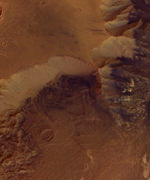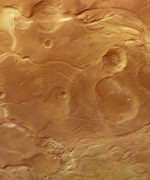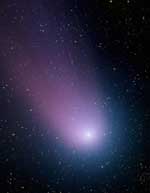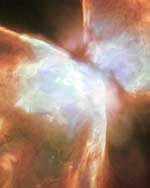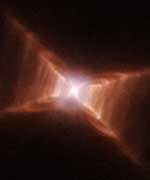
Image credit: Hubble
Astronomers may not have observed the fabled “Stairway to Heaven,” but they have photographed something almost as intriguing: ladder-like structures surrounding a dying star.
A new image, taken with NASA’s Hubble Space Telescope, reveals startling new details of one of the most unusual nebulae known in our Milky Way. Cataloged as HD 44179, this nebula is more commonly called the “Red Rectangle” because of its unique shape and color as seen with ground-based telescopes.
Hubble has revealed a wealth of new features in the Red Rectangle that cannot be seen with ground-based telescopes looking through the Earth’s turbulent atmosphere. Details of the Hubble study were published in the April 2004 issue of The Astronomical Journal.
Hubble’s sharp pictures show that the Red Rectangle is not really rectangular, but has an overall X-shaped structure, which the astronomers involved in the study interpret as arising from outflows of gas and dust from the star in the center. The outflows are ejected from the star in two opposing directions, producing a shape like two ice-cream cones touching at their tips. Also remarkable are straight features that appear like rungs on a ladder, making the Red Rectangle look similar to a spider web, a shape unlike that of any other known nebula in the sky. These rungs may have arisen in episodes of mass ejection from the star occurring every few hundred years. They could represent a series of nested, expanding structures similar in shape to wine glasses, seen exactly edge-on so that their rims appear as straight lines from our vantage point.
The star in the center of the Red Rectangle is one that began its life as a star similar to our Sun. It is now nearing the end of its lifetime, and is in the process of ejecting its outer layers to produce the visible nebula. The shedding of the outer layers began about 14,000 years ago. In a few thousand years, the star will have become smaller and hotter, and will begin to release a flood of ultraviolet light into the surrounding nebula; at that time, gas in the nebula will begin to fluoresce, producing what astronomers call a planetary nebula.
At the present time, however, the star is still so cool that atoms in the surrounding gas do not glow, and the surrounding dust particles can only be seen because they are reflecting the starlight from the central star. In addition, there are molecules mixed in with the dust, which emit light in the red portion of the spectrum. Astronomers are not yet certain which types of molecules are producing the red color that is so striking in the Red Rectangle, but suspect that they are hydrocarbons that form in the cool outflow from the central star.
Another remarkable feature of the Red Rectangle, visible only with the superb resolution of the Hubble telescope, is the dark band passing across the central star. This dark band is the shadow of a dense disk of dust that surrounds the star. In fact, the star itself cannot be seen directly, due to the thickness of the dust disk. All we can see is light that streams out perpendicularly to the disk, and then scatters off of dust particles toward our direction. Astronomers found that the star in the center is actually a close pair of stars that orbit each other with a period of about 10 1/2 months. Interactions between these stars have probably caused the ejection of the thick dust disk that obscures our view of the binary. The disk has funneled subsequent outflows in the directions perpendicular to the disk, forming the bizarre bi- conical structure we see as the Red Rectangle. The reasons for the periodic ejections of more gas and dust, which are producing the “rungs” revealed in the Hubble image, remain unknown.
The Red Rectangle was first discovered during a rocket flight in the early 1970s, in which astronomers were searching for strong sources of infrared radiation. This infrared source lies about 2,300 light-years from Earth in the direction of the constellation Monoceros. Stars surrounded by clouds of dust are often strong infrared sources because the dust is heated by the starlight and radiates long-wavelength light. Studies of HD 44179 with ground-based telescopes revealed a rectangular shape in the dust surrounding the star in the center, leading to the name Red Rectangle which was coined in 1973 by astronomers Martin Cohen and Mike Merrill.
This image was made from observations taken on March 17-18, 1999 with Hubble’s Wide Field Planetary Camera 2.
Original Source: Hubble News Release

